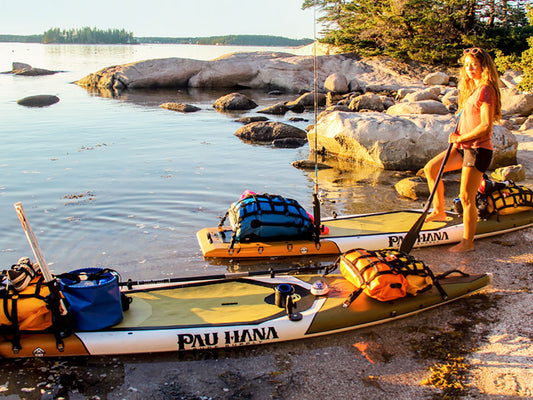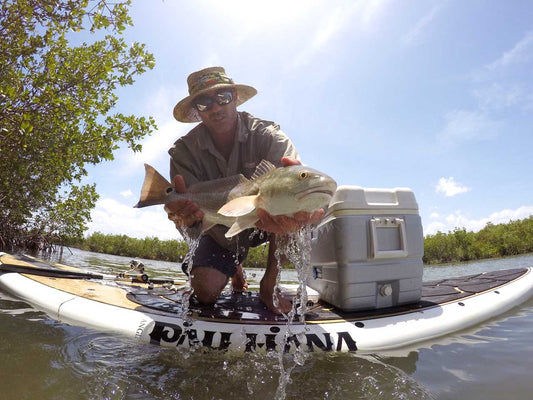Because Casting from a Paddleboard Is Way More Fun Than Sitting in a Boat
Let’s be honest - some hobbies just hit different. Paddleboarding gives you freedom. Fishing gives you patience (and sometimes dinner). Combine the two, and you’ve got SUP fishing - a perfect recipe for stoke, solitude, and just maybe even a snapper or two.
If you’ve ever looked at your paddleboard and thought, “I bet I could fish from this,” you’re absolutely right. Here’s how to plan your very first SUP fishing trip - Pau Hana style.
Why SUP Fishing?
Picture this: you’re gliding across glassy water, the morning mist still rising, rod in hand, no motor noise - just birds, breeze, and the quiet buzz of anticipation. That’s SUP fishing.
Compared to a kayak or boat, paddleboards give you a few clear advantages:
- Stealth mode activated. You can sneak right up to feeding fish without spooking them.
- Access the inaccessible. SUPs can slide into super shallow coves, mangrove edges, or hidden estuary channels which most boats can’t touch.
- Better visibility. Standing gives you a higher vantage point - spot fish before they spot you.
- Ultra-portable. Inflatable boards roll into your boot, backpack, or even check-in as luggage on planes.
SUP fishing’s not just about catching fish - it’s about freedom, presence, and that pure time after work escape.
Step 1: Pick the Right Board
Not every paddleboard is cut out for the job. You’ll want a stable, wide deck with room for gear and confidence to move around.
For beginners, look for boards in the 10’6″ - 11′ range with at least 32″ - 36″ of width. Inflatable boards are usually the go-to - lightweight, durable, and easy to transport.
Some top styles for fishing:
- All-round SUPs: Versatile and stable. Great for paddlers who want to fish one day and cruise the next.
- Fishing-specific boards: Like the Big EZ Angler - high-volume, ultra-stable, and loaded with SeaMount® accessory points for all the rod holders and gear you could ever need.
- Inflatables: Perfect if you’re off to remote lakes or islands. The extra thickness (usually 6″) adds buoyancy for more gear and balance.
Pro Tip: A textured traction pad is your best friend when you’re juggling rods, reels, and balance.
Step 2: Gear Up (Smartly)
You don’t need a full tackle shop - just the essentials that fit your board and style of fishing.
- Rod & Reel: Choose a medium-action spinning setup - easy to manage while standing and casting.
- Anchor: Keeps you in place when the tide or wind tries to boss you around. Look for folding or claw anchors with at least 5 m of rope or more.
- Rod Holder: Attach it to your board’s accessory attachment point. Bonus points if it has a safety strap - boards can tip, rods can sink.
- Portable Fish Finder: Bluetooth models pair with your phone and help you locate fish without guesswork.
- Cooler: Doubles as a seat and a place to stash cold drinks or keep your catch fresh.
- Tackle Bag: A lightweight sling bag or waterproof backpack with compartments for lures, pliers, and line.
Keep your setup minimal - the less clutter on deck, the easier it is to move, cast, and (inevitably) celebrate your first catch dance.
Step 3: Dress the Part
What you wear can make or break the day. A long-sleeve UV shirt, quick-dry shorts, hat, and sunnies are a non-negotiable in summer. If you’re out early or in cooler months, add a thermal layer or light wetsuit.
Neoprene booties give you traction and protect against hooks and rocks. And always wear your PFD - it’s the one accessory that actually looks good with everything.
Step 4: Know Your Spot
Not all waters are created equal. In New Zealand, some epic SUP-fishing locations include:
- Bay of Islands: Calm bays and plenty of snapper.
- Lake Taupō: Ideal for trout fishing - early mornings are magic.
- Raglan Harbour: Perfect mix of salt and serenity.
- Marlborough Sounds: Sheltered coves made for silent SUP missions.
Check local regulations - bag limits, fishing zones, and protected areas. A quick peek at NIWA or local council sites can save you a fine (and some embarrassment at the ramp).
Step 5: Safety & Comfort
Even pros get caught out by wind and weather. Always check the forecast, carry a leash, and let someone know where you’re going. Bring sunscreen, a rain jacket, an extra layer, snacks, and more water than you think you’ll need.
A small first-aid kit is a good idea - hooks have a funny way of finding fingers.
Step 6: Master Your Moves
Before you load up your board with all the gear, practice paddling with a light setup. Get comfortable turning, kneeling, and standing with your fishing gear onboard. Try casting while balancing.
The trick? Bend your knees and move slow. Your board’s your dance floor - not your gym bench.
Bonus: Tips From the Tribe
- Early bird = better bite. Fish feed more aggressively at sunrise and sunset.
- Stealth mode matters. Approach quietly - no sudden splashes or anchor drops.
- Keep it tidy. Loose line and hooks on deck can end a trip fast.
- Use a drift sock. It slows your drift in light wind - great for covering more water.
- Join a community. Local SUP fishing clubs are gold for sharing spots, tips, and post-paddle stories.
The Pau Hana Way
SUP fishing isn’t about how many fish you land - it’s about how far from shore your mind can wander. It’s about slowing down, tuning in, and finding those quiet, glassy moments between casts.
Pack your board, rig your rod, and follow the call of the water. You might even come back with dinner… or just a better mood. Either way, you’ll win.





